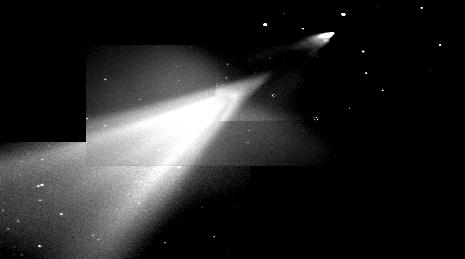 Greetings
Herbert
Greetings
Herbert Newsgroups: sci.astro,sci.space From: [email protected] (Allen Thomson) Subject: Re: CCD Image of Barium Cloud Date: Sat, 7 May 1994 00:04:22 GMT Lines: 8 Satellite watchers think that the diffuse object seen in Europe may be venting from the Centaur upper stage of the Titan IV carrying a classified satellite launched from Florida this week. The high inclination of the launch leads to the speculation that the payload and upper stage may have been put into a Molniya-type orbit. Observers are trying to spot either of the objects.
From: [email protected] (Allen Thomson) Newsgroups: sci.space Subject: USA 103/Centaur (was: Barium Cloud) Date: Sat, 7 May 1994 13:56:07 GMT Lines: 115 This message from Joel Runes appeared on the Celestial BBS; in the interests of timeliness, I'm reposting it here before receiving his approval to do so. Please respond directly to Joel as well as posting here if you have any observations to contribute. ---------------------------------------------------------------------------- Observers throughout Europe reported sighting a luminous object up to 30 arc-minutes in diameter and as bright as 2nd magnitude. The observations took place after sunset May 3rd as early as 2022 UTC and until at least 2200 UTC. Several of the observations were reported to Brian Marsden at the Harvard-Smithsonian Center for Astrophysics. After determining that the object was not a comet, the observations were handed off for determination of possible earth-orbiting phenomena. Analysis of the data suggest that the object is most likely to be a cloud of vented residual propellants from a Centaur upper stage. A Titan IV-Centaur was launched from Launch Complex 41 at Canaveral Air Force Station at 1555 UTC on the 3rd. Press releases and other reports claim that the launch was into an initial 57 degree inclination, that the Titan stages were in suborbital trajectories impacting off the east coast of North America, and that a burn of the Centaur stage placed the classified payload, USA 103, and Centaur into a parking orbit. Speculation as to the final orbit for the payload centered on the prospect of being boosted into an elliptical Molniya-type orbit with perigee in the far Southern Hemisphere to provide prolonged observations of the Northern Hemisphere. Because systems of the Centaur stage are battery-powered, the second Centaur maneuver was anticipated within several orbits after launch. The European observations indicate that a Centaur maneuver occurred about an hour after launch over the Southern Ocean boosting the orbit's apogee to approx. 40,000 km. Either as a part of the apogee-raising maneuver or as a separate maneuver 2 - 3 hours after launch, the inclination was changed from 57 degrees to more than 62 degrees, and the RAAN moved eastward by 8 - 10 degrees. Following the final maneuver of the Centaur Stage and separation of the payload, it is customary to vent residual propellants to prevent generation of debris from combustion or explosion. The cloud of residual propellants was the likely phenomenon observed. ---------------------------------- A preliminary "working orbit" for the Centaur Stage based on the European observations is being released to facilitate efforts by observers to find the stage and/or payload. This working orbit is far from perfect. I will continue my efforts to better fit the orbit to the European observations and urge others to try their hands at it. High quality observations from a group of Italian astronomers headed by L. Bittesini (made from Farra d'Isonzo) and from the Ondrejov Observatory in the Czech Republic by Petr Pravec and R. Peresty are summarized below: Here are some approximate positions from the Ondrejov Observatory, Czech Republic (longitude 14.7837 deg east, rho cos/sin phi' = 0.64530, +0.76148) "comet" 1994 05 03.8588 03 38 00 +49 10 2 T 557 "comet" 1994 05 03.8672 03 49 30 +50 32 557 "comet" 1994 05 03.8714 03 54 50 +50 53 557 "comet" 1994 05 03.8799 04 01 40 +51 28 557 Here are the UT, R.A. and Decl. (J2000.0) of the object, as observed from Farra d'Isonzo, Italy (longitude 13.53 deg east, rho cos phi' = 0.697, rho sin phi' = +0.715 (rho being the geocentric distance in earth-equatorial radii and phi' the geocentric latitude). CCAF37 C1994 05 03.84928 03 23 25.77 +48 39 50.8 595 CCAF37 C1994 05 03.85325 03 28 25.50 +49 19 32.2 595 CCAF37 C1994 05 03.85869 03 35 18.26 +50 10 58.6 595 CCAF37 C1994 05 03.86275 03 40 26.67 +50 47 20.0 595 CCAF37 C1994 05 03.86735 03 46 16.41 +51 26 44.9 595 CCAF37 C1994 05 03.87228 03 52 32.65 +52 06 56.2 595 CCAF37 C1994 05 03.87641 03 57 50.46 +52 38 50.4 595 Additional observation reports: Approx positions: 03 40 +50 (1950) 20:30 Frauenstein 04 10 +50 (1950) 20:55 Luebeck 04 30 +54 (1950) 21:25 Luebeck 03 57 +50.75 (1950) 20:53 from site 10.65deg E, 52 deg 7 N 22:00 Object faded The working orbit: USA 103 Centaur 9.1 3.0 0.0 5.0 39736 x 618 1 23098E 94026B 94123.70803633 .00003650 00000-0 33989-3 0 15 2 23098 62.3466 8.4497 7365366 268.3594 359.9956 2.00624612 27 ---------------------------------- Anyone with improved elements consistent with these observations is requested to distribute them promptly and widely since the prospects of observing USA 103 and/or the Centaur Stage will diminish rapidly. Reports of observations of either object are also solicited. Joel Runes [email protected]